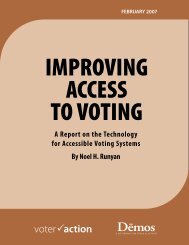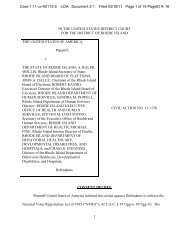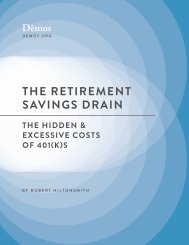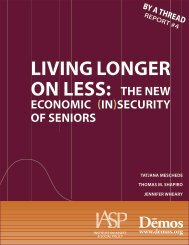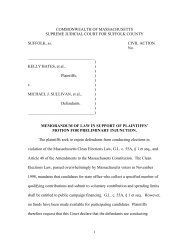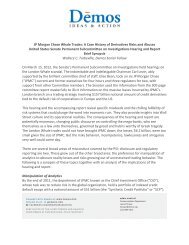Philip Harvey - Demos
Philip Harvey - Demos
Philip Harvey - Demos
You also want an ePaper? Increase the reach of your titles
YUMPU automatically turns print PDFs into web optimized ePapers that Google loves.
3. It’s Targeted to ose Who Need Jobs Most<br />
e undeserved pain of this economic crisis has not been felt evenly. While the jobless<br />
rate in our nation’s capital was 9.6 percent in December 2010, it was twice as high in<br />
Hancock County, Georgia and three times as high in Imperial County, California. 6<br />
Young workers, workers without a college degree and workers of color at all education<br />
levels are considerably more likely to be unemployed than the average American. 7<br />
Unemployment in the nancial industry is only 7.5 percent, but is over 22 percent in<br />
construction. 8 ere are roughly four million “99ers” collecting whose job search has<br />
outlasted their unemployment insurance 9 —which doesn’t even capture the at least 56<br />
percent of workers who don’t qualify for unemployment. 10<br />
Indirect stimulus measures such as tax cuts and benets payments do not guarantee that<br />
the jobs will be created in the communities, sectors and populations hardest-hit by the<br />
recession. e strategy can be designed to target these job-seekers, reducing inequality<br />
and blunting the most extreme suering felt in our nation.<br />
Eligibility requirements could consider the length of time a person has been<br />
unemployed and their nancial need for work, to ensure that those who are hurt most<br />
by private sector job losses are the rst to benet from the program. e program could<br />
also be designed to recruit workers with skills from sectors with high job losses, such as<br />
construction and manufacturing.<br />
4. It Meets Vital National and Community Needs<br />
e proposal is designed to create jobs that ll unmet needs in the job-seekers’ own<br />
communities. ese unmet needs include weaknesses in our human and physical<br />
infrastructure. For example, U.S. ranks 27th—nearly last—among developed countries<br />
when it comes to investments in education, health care and other vital social needs 11 ,<br />
and 46 states have recently cut back on social services funding due to budget shortfalls. 12<br />
Putting Americans directly to work in areas such as health care, child care, education,<br />
recreation, elder care, and cultural enrichment could expand and improve the quality of<br />
these vital public services.<br />
Our physical infrastructure is also unworthy of our nation. One out of every three U.S.<br />
roads is in poor or mediocre condition. 13 At least 26,000 schools are in need of major<br />
repairs. 14 Direct public job creation would help rebuild America’s infrastructure -- an<br />
economic investment in and of itself -- with improvements to schools, roads, bridges,<br />
and energy eciency in buildings and homes nationwide.<br />
e possibilities are well-illustrated by the accomplishments of the Civil Works<br />
Administration (CWA), an emergency job creation program that operated for about<br />
four months over the winter of 1933-34 in the United States. Established by President<br />
Roosevelt in early November, 1933, the CWA went from a mere proposal to a fully<br />
operational program with over 4 million employees in less than two months.<br />
Despite its hurried implementation, the program’s achievements are truly astounding.<br />
In Chicago, over 11 thousand CWA workers laid brick pavements in a major streetimprovement<br />
project. Approximately 60,000 public buildings were repaired or<br />
<strong>Philip</strong> <strong>Harvey</strong> 3




